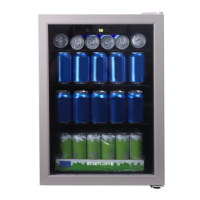desired cooler internal temperature (lowest temperature setting is 40°F).
6. Allow several hours for the beverage center to cool to the desired lower temperature.
Note: It is normal for temperature variances to occur inside the unit, and areas near the door will have slightly
warmer temperatures.
Shelving (See Fig. #2)
To remove or replace a full-width slide-out shelf:
1. Gently tilt the shelf up and slide forward until the shelf has been completely removed.
2. To replace the shelf, gently slide the shelf back.
Normal Operating Sounds You May Hear
Boiling water, gurgling sounds or slight vibrations that are the result of the refrigerant circulating through the
cooling coils.
Compressor makes operational sounds when cycling on and off.
Proper Beverage And Wine Center Care & Cleaning
Cleaning and Maintenance
Warning:
To avoid electric shock, always unplug your beverage and wine center before cleaning. Ignoring this warning may
result in death or njury.
Caution:
Before using cleaning products, always read and follow manufacturer’s instructions and warnings to avoid personal
injury or product damage.
General:
Prepare a cleaning solution of 3-4 tablespoons of baking soda mixed with warm water. Use sponge or soft cloth,
dampened with the cleaning solution, to wipe down your beverage center.
Rinse with clean warm water and dry with a soft cloth.
Do not use harsh chemicals, abrasives, ammonia, chlorine bleach, concentrated detergents, solvents or metal
scouring pads. Some of these chemicals may dissolve, damage and/or discolor your beverage and wine center.
Door Gaskets:
Clean door gaskets every three months according to general instructions. Gaskets must be kept clean and
pliable to assure a proper seal.
Petroleum jelly applied lightly on the hinge side of gaskets will keep the gasket pliable and ensure a good seal.
Defrosting Your Beverage And Wine Center
Your beverage and wine center is designed with a manual defrost system. The beverage and wine center surfaces
will defrost, when the unit is unplug. Water from the unit is disposed of automatically, by means of being channeled
onto a drip tray located on the compressor. Heat transfer from the compressor causes this water to evaporate.
Power Interruptions

